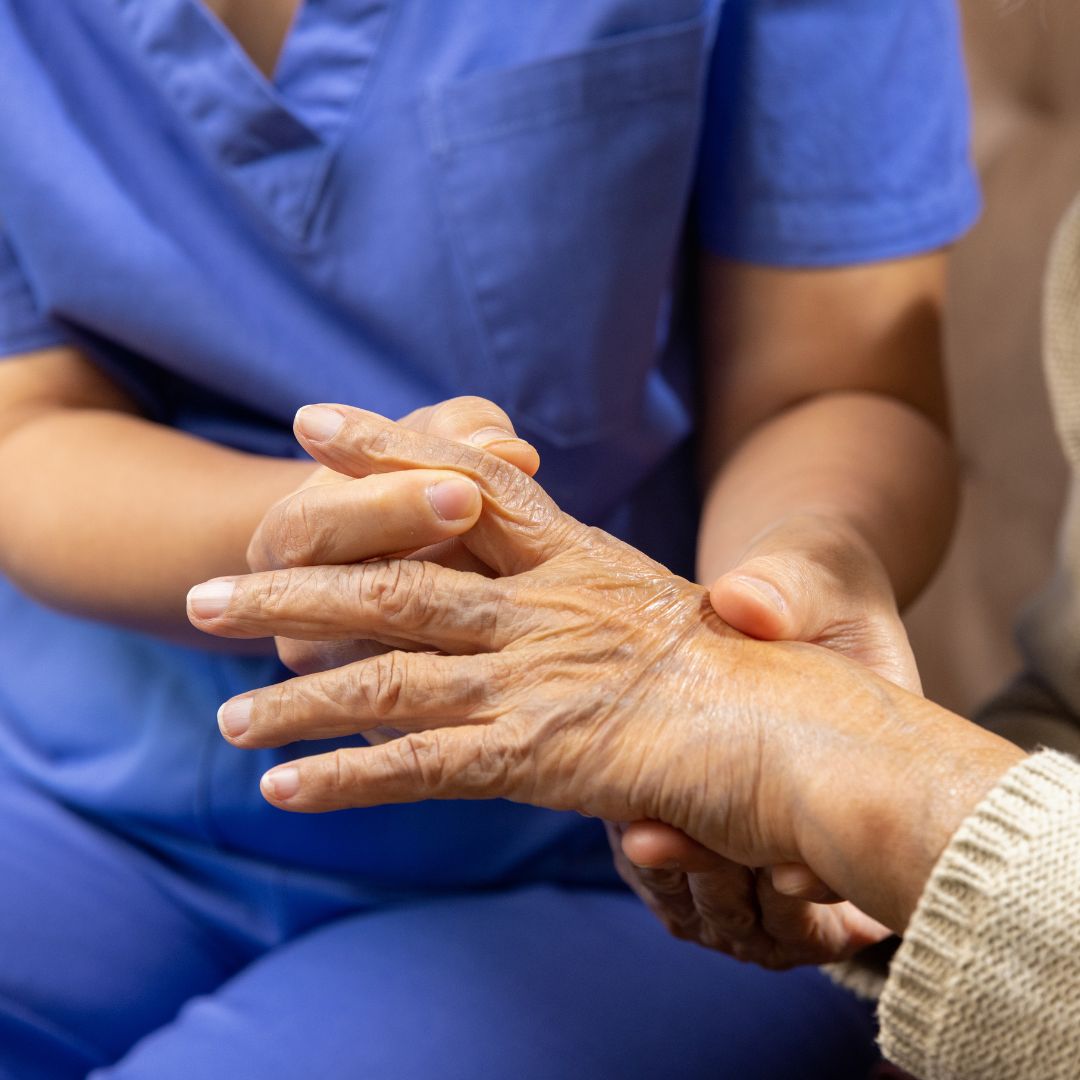Bone material is constantly being broken down and built anew, simultaneously. During childhood, we build new bone much faster than we break it down. When we stop growing, these processes even out. In our later years, bone tends to break down faster than it is rebuilt.
Whether or not you are at risk for brittle bones and breaks is based on a few factors. Some are genetic, such as family history, your frame size, and how much bone mass you accumulated at your peak. Some factors are related to hormones. Overactive thyroid, parathyroid, or adrenal hormones can cause bone loss. So can certain medications, excessive alcohol, or tobacco consumption [1].
Sex hormones have a protective effect on bone health. Those who are going or have gone through menopause experience a sudden drop in estrogen, which is often accompanied by a drop in bone density [1].
Some people develop bone density challenges due to nutritional deficiency. Low calcium intake is known to contribute to diminished bone density, early bone loss, and an increased risk of fractures. Eating disorders, gastrointestinal diseases, and surgeries can also lead to low mineral intake or absorption that results in the same challenges down the road [1].
Luckily, nutritional deficiencies can often be resolved with supplementation. Increased intake of bone minerals and vitamins can support the longevity of bones and bone health.

Is calcium enough for healthy bones?
When we think about vitamins and minerals for bone health, calcium is the obvious number one. Calcium is the main material component of bone. If you are concerned with maintaining healthy bone density, you may be considering a calcium supplement. This may be the right choice for you and your body, but there are still more factors to consider when it comes to nutrition for bone health.
Although it dominates in composition, calcium is not the only essential mineral required to build new bone. Magnesium and boron are also important to building and maintaining healthy bone density. These minerals are also likely to be lacking in the typical American diet.
In terms of vitamins, vitamin D, like calcium, is well known to be important for bones. Less known is vitamin K. Vitamin K also plays important roles in bone maintenance and is commonly insufficient in the diet.
As you read on, we will address the benefits of each of these nutrients individually. However, you can also take supplement blends that contain nutrients to bone health and deliver a balanced blend of nutrition to support the maintenance of healthy bones as we age.
Is calcium supplementation safe?
You may have heard that calcium supplements can cause more harm than good. The truth of this statement depends heavily on the context.
If you need more calcium, a calcium supplement can help. Calcium supplements support healthy bones, normal blood pressure and clotting, muscle contraction, and nerve transmission [3]. Calcium may even reduce the risk of falling, as it contributes to muscle function and stability [2].
If you take far more calcium than you need, it can hurt. Calcium overdose can contribute to kidney stones or symptoms associated with hypercalcemia
A lot of things can be dangerous when you overdo it. One glass of wine nightly offers numerous health benefits, while five glasses nightly is likely to cause numerous health problems. Even too much water can hurt you.
As adults, we should be consuming about 1000 mg of calcium daily until age 50. For those who menstruate, menopause is the time to up our calcium intake to 1,200 mg daily. Those who do not menstruate should increase their intake to 1,200 mg daily by age 70. Most adults are likely not reaching these daily thresholds with diet alone [2].
If you can get all the calcium you need from the diet, that is best. If you can get it incrementally throughout the day, that is ideal for gastrointestinal and cellular absorption. Unfortunately, calcium is found most abundantly in dairy and animal products, which many of us cannot or do not consume in great quantities.
Be sure to follow supplement guidelines and consider a blood test to analyze your calcium levels before adding more calcium to your supplement regimen.
What do I need for healthy bones besides calcium?
Vitamin D
Although vitamin D is not technically considered an essential vitamin, its availability is essential for healthy bones. Without vitamin D, our bodies cannot effectively absorb calcium.
Unfortunately, vitamin D deficiency is an epidemic in Westernized nations [4]. It is estimated that 40% of Europeans, 37% of Canadians, and 25% of US Americans suffer from low vitamin D status [4]. Rates are higher in underserved communities, more melanated racial groups, the elderly, and the very young [4].
Our bodies make vitamin D endogenously, in response to unfiltered exposure to the sun. The more melanated (pigmented) skin appears the more time in the sun one must spend to make healthy vitamin D levels. Daytime work and school schedules, warm clothing, and sunscreen all interfere with our skin from getting the exposure needed to produce sufficient levels of vitamin D.
Vitamin D insufficiency or deficiency is associated with numerous health challenges (in addition to bone health), and supplementation is an effective way to raise and maintain a healthy vitamin D status. It is also a nutrient that you can take too much of, so consider consulting a physician before starting a high-dose vitamin D supplement.
Vitamin K
Vitamin K was named for the German word “koagulation”, as it is known for its role in blood coagulation and healing. Studies have also shown, however, that poor Vitamin K intake is linked to low bone mass, osteoporosis, and hip fractures in men and women, and too low bone density in women [5].
There are two types of vitamin K: K1 and K2, and K2 appears to be most important to bone health [5]. People in Western cultures don’t often get enough of either form but are especially lacking in K2. While K1 can be found in cruciferous vegetables and greens, K2 is only found in grass-fed meat and dairy, or in fermented foods. Increasing consumption of fermented foods can help raise your K2 status, but a supplement is also an excellent option.
A 2013 study found that taking 180 mcg of vitamin K2 daily helped reduce bone loss in healthy, postmenopausal women [5].
Magnesium
Magnesium is a mineral involved in hundreds of biochemical reactions in the body. A few of which are related to bone health, and specifically, bone mineral density. Magnesium deficiency is associated with poor bone density, independent of calcium in the diet [6,7].
Magnesium is involved in the formation of different bone cell types (osteoclasts vs. osteoblasts). So, a magnesium deficiency can actually change the structure and crystallization of new bone during growth and repair [7]. Magnesium deficiency is associated with lower levels of parathyroid hormone, lower activated vitamin D, higher levels of inflammatory cytokines, endothelial dysfunction, and reduced blood flow [7]. All of which have negative effects on bone homeostasis and remodeling [7].
On the other hand, people with higher magnesium intake tend to have higher bone density, which is associated with a lower risk of fractures and osteoporosis [6]. One month-long study found that 290 mg/day of supplemental magnesium suppressed bone turnover in postmenopausal women [7]. This finding suggests bone loss is reduced when dietary magnesium intake is sufficient.
Exercise
Your bones need more than good nutrition to stay healthy. They need regular exercise.
The stronger our bones start out, the longer they last. When children receive education about nutrition and exercise for bone health and participate in bone-supportive practices throughout their growing years, they tend to develop more bone mass and higher bone density, which are associated with longer-lasting bone mass and density later in life [8].
If you didn’t exercise much as a kid, it’s not too late. Even those with previous fractures have been shown to build stronger bones with exercise [9]. Exercise, specifically, weight-bearing and resistance exercise, has been shown to reduce the risk of falls and fractures [9]. Weight-bearing exercise is anything in which you resist gravity to move your body (hiking, climbing stairs, running, dancing, tennis, etc.). Resistance training is using your muscles and bones to resist the pressure of a weight (weight-lifting, pilates, yoga, etc).
Whatever you choose, work on your balance and posture. Exercises that challenge balance can prevent falls by 20-40% [9]. Exercise that improves spinal posture can reduce the risk of vertebral fracture independent of falls [9].
- Mayo Clinic. “Osteoporosis: Symptoms and Causes.” https://www.mayoclinic.org/diseases-conditions/osteoporosis/symptoms-causes/syc-20351968#:~:text=A%20lifelong%20lack%20of%20calcium,in%20both%20men%20and%20women.
- Chiodini, Iacopo, and Mark J. Bolland. “Calcium supplementation in osteoporosis: useful or harmful?.” European journal of endocrinology 178.4 (2018): D13-D25.
- Del Valle, Heather B., et al., eds. “Dietary reference intakes for calcium and vitamin D.” (2011).
- Amrein, Karin, et al. “Vitamin D deficiency 2.0: an update on the current status worldwide.” European journal of clinical nutrition 74.11 (2020): 1498-1513.
- Richens, Mark. “Vitamin K2 Plays Key Role in Bone Health”. American Bone Health Website. Oct 15, 2019. https://americanbonehealth.org/nutrition/vitamin-k2-plays-key-role-in-bone-health/
- American Bone Health. “Minerals for Bone Health.” American Bone Health Website. September 28, 2016. https://americanbonehealth.org/nutrition/minerals-for-bone-health/#:~:text=Magnesium%20is%20important%20for%20healthy,improve%20their%20bone%20mineral%20density.
- Ask the Scientists. “Magnesium and Bone Health”. Accessed May 19, 2022. https://askthescientists.com/magnesium-bone-health/
- Economos, Christina D., et al. “Beat osteoporosis—nourish and exercise skeletons (BONES): a group randomized controlled trial in children.” BMC pediatrics 20.1 (2020): 1-14.
- Giangregorio, Lora M., et al. “Build better bones with exercise (B3E pilot trial): results of a feasibility study of a multicenter randomized controlled trial of 12 months of home exercise in older women with vertebral fracture.” Osteoporosis International 29.11 (2018): 2545-2556.
Share:
Related Posts

Goodbye Pie Chart, Hello Phase 1 Sliders
Written by Allison Smith, ND | 2025 As we usher in a new era of DUTCH testing which leaves behind the concept of the three-way

Introducing the DUTCH Dozen
Written by Kelly Ruef, ND | 2025 Hormone testing can be complex, which is why Precision Analytical developed the DUTCH Dozen, an interpretive framework that

DUTCH Report Enhancements
Written by Hilary Miller, ND | 2025 Precision Analytical have released the newest version of the DUTCH Test. This is the report’s most significant update

Gallbladder Health 101: What It Does and How to Keep It Working Well
Written by Ashley Palmer & Pooja Mahtani | 2025 The gallbladder may not get much attention compared to the gut, but it plays a central

Can You Bring Vitamins on a Plane? How To Travel with Supplements
Written by Austin Ruff | 2024 Are you traveling for a work conference, an athletic competition, or a weekend getaway? Just because you’re leaving home
